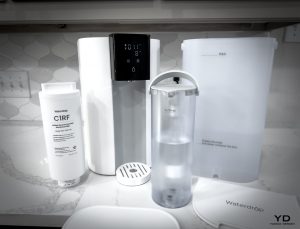SOMMAIRE
If you buy an item via links on this page, we may earn a commission. Our editorial content is not influenced by commissions. Read the full disclosure.
Irises are extremely versatile in the garden, with species that can tolerate soggy soil, part shade, full sun, and even drought. With over 300 species offering an astounding array of colors and sizes to suit most floral projects.
Relatively easy to grow, low maintenance, and able to cope with dry or wet conditions, they’re perfect for the beginner and experienced gardener alike.
Interested in growing irises? They need to be planted in late summer or fall, so plan ahead if you want to enjoy their brilliant display.
What Are Irises?
Categorized as herbaceous perennials, irises die back to the soil each year to return the next from underground rhizomes or bulbs. These plants are members of the Iridaceae family and can be grown from rhizomes, seeds, and bulbs.
The blooms appear after the daffodils and tulips open in the spring, typically providing color and splendor from spring through early summer. Unlike tulips and daffodils, the leaves of these plants persist, often straight through fall until winter. Some are even evergreen.
Some irises have variegated foliage, and others are solid. The flowers can range from massive and full to elegantly simple. That’s while you’ll find many people in your neighborhood growing irises. They’re so easy and varied!
Recognized worldwide, the iris has been used as a symbol by French nobility and Egyptian royalty. In the US, enthusiasts can join the American Iris Society to discover unique species and cultivars and to share tips.
Irises are named after the Greek goddess Iris, a messenger for the gods. The unique blossoms attract all kinds of pollinators, especially hummingbirds.
Our Favorite Iris Hybrids and Species
Most people recognize the striking bearded irises right away, but there are many more hybrids and species that are worth checking out. Here are ten types worth taking a look at if you’re interested in growing irises:
Bearded

A long-term keeper, I. x germanica can grow for up to 20 years under the right conditions. This plant prefers six-eight hours of sunshine in free-draining soil.
This plant grows from creeping rhizomes that are typically partially exposed out of the soil.
They come in a range of sizes from dwarf to tall, starting at just six inches and up to 40 inches. Dwarf bearded irises typically start blooming in March. Larger types can start blooming as late as June.
These plants are known for their easy care. You don’t have to do much to keep them happy. The shorter type is suitable for pots and taller ones make a great border plant.
We recommend that you support the taller types with garden stakes. Wherever you grow them, they should be divided every three-five years.
Bearded irises are hardy in USDA Hardiness Zones 3-10.
Siberian

Siberian irises (I. sibirica) are easily recognized by their smaller, daintier blooms compared to the bearded iris. They’re a bit more adaptable than their showier cousins, so don’t discount them if you’re interested in growing irises.
This species spreads through rhizome roots. If you need an iris that can grow in a darker area, it’s tolerant to some shade. Three hours of sunlight or more is perfectly fine.
You should soak the rhizomes in clean water overnight before planting in order to rejuvenate the rhizome.
Over time, this plant will form large, tight grouping of foliage and flowers, and can grow up to 34 inches in height.
You only need to divide the plants when they become overly compact or show signs of decline in growth.
These tend to bloom after the tall bearded iris and are suitable in Zones 3–9.
Toughleaf

Toughleaf iris (I. tenax) is an excellent groundcover option. This species is native to northwestern California, western Oregon, and southwestern Washington.
While they aren’t the largest, showiest flowers, they make good cut flowers for posies. The blossoms are long-lasting and are open from late spring to mid-summer.
These plants grow up to 12 inches tall with dark green foliage. Blooms come in shades of creams, yellows, blues, and purples.
Also called the Pacific Coast bearded iris, it’s heat tolerant and adapts well to partially shaded areas.
This species prefers soil that is free draining, such as sand or loa. It can even tolerate partial clay but will struggle if its rhizomes sit in water. Grow in Zones 5-9.
Dwarf Crested

A little gem that is perfect for shadier parts of the garden due to its suitability for woodland-type gardens with peat-based soils, dwarf crested (I. cristata) grows to just six inches tall. It has a rarer cousin called dwarf iris (I. verna) that looks similar.
This species is native to eastern North America and is becoming a more popular option for those growing irises.
Distinctive due to size, dwarf crested irises have violet-blue to purple-toned petals, and a hint of yellow and white in the middle.
This will spread through rhizomes under the soil to fill in a bare spot.
Grow dwarf crested irises in pots or low borders with humus-rich soil and plenty of moisture. Ideal for Zones 5-8.
Blue Flag

Adapted to wet areas like a pondside or a bog garden, blue flag irises (I. versicolor) are perfect for those areas that have some standing water.
Blue flag is an aquatic perennial and has high water requirements. It’s best suited to clay-based, loamy soil.
Native to the eastern United States, it will establish itself quickly in the right conditions. Full sun is appreciated, but it will thrive in low-light areas, with blooms from spring to summer in Zones 3-9.
Louisiana

Vigorous and tall at two-four feet, the Louisiana iris (I. hexagona) flowers with massive blossoms that can be up to four inches in diameter. The petals come in tone across the rainbow spectrum of cream, blue, bronze, white, yellow, pink, red, purple, and nearly black.
Its native growing area and habitat are the wetlands of Louisiana, so it can tolerate some standing water. Hybrids have been produced that can handle a wide range of growing conditions, though.
This one has different requirements from many irises. You must cover the rhizomes with mulch if they aren’t nestled in water or boggy soil.
Blooms with 6-8 hours of sun, but they will be tolerant to some shade in Zones 4-10.
Dutch

With astounding long stems up to 22 inches tall topped with dramatic flowers, Dutch irises (I. x hollandica) grow from teardrop-shaped bulbs.
This hybrid is adored by flower farmers and florists for its straight long stem, durability, long vase life, and diversity of colors. It’s low maintenance and versatile, provided it has six-to-eight hours of sun, even in partial shade.
Due to its long stems, it may require staking for support for wind-prone areas. If you’re growing irises, choose this one for Zones 5-9.
Algerian

Algerian irises (I. unguicularis) bloom from late fall to early spring with lavender-colored flowers on 18-inch stems. It has grass-like leaves.
Due to its slow germination, patience is required when growing this species from seed.
Place this one in a sheltered sunny position to encourage the splendor this ris offers, with its vibrant purple petals with yellowish-orange throats.
It prefers to remain in the same spot as it does not like its roots being disturbed. Hardy in Zones 7-9.
Douglas

This mini iris (I. douglasiana) has become popular as it’s quite hardy and ideal for rockeries, small spaces, shaded areas, windy spots, pots, and garden borders.
Growing up to 32 inches tall and spreading through a clumping rhizome root system, its ability to adjust and thrive in various environments has seen significant breeding interest. Growers are working to create a more diverse color pallet and hybrids.
A stunning native wildflower, indigenous to the Pacific Coast region, is a pale lavender with a yellow throat. Hybrids can be found in deep purple, white, lilac, blue, and deep red.
Douglas irises have a low water requirement and do well in soils that are free draining in Zones 6-9.
Black

Black irises (I. chrysographes) truly stand out. Growing to 20 inches and far less common than others on the list, it’s instantly recognizable by its almost black, purple blooms. If you have a black garden and you want to try growing irises, this is your best option.
Tolerant to full sun and partial shade and some standing water, you can plant it near water features, in wild meadow gardens, and in large pots and borders.
This dependable performer has lush, large blooms, similar to those of the bearded iris.
Black irises spread via rhizome roots, maturing at five years when division is required. This species is hardy to Zones 3-9.
Growing Irises
Whether growing irises from bulbs, seeds, or rhizomes,
Most irises need full sun, for the most part. Even those that will tolerate some shade need at least six hours of sunlight in order to bloom well, with a few exceptions that will grow in partial shade.
Plant your bulbs or rhizomes in the garden around October for spring and summer flowering. Those with long winters might even plant as early as September.
Irises stemming from rhizomes should have some of their root system above the soil to absorb the sunlight, except Louisiana irises, where some mulch on the rhizomes is needed.

When growing irises from bulbs and seeds, plant them close to the surface, about a half to three-quarters inch deep for bulbs. Just barely cover seeds, as light is required for germination and growth.
Taller varieties will benefit from supports, particularly when the weather is unpredictable or placed in more exposed parts of the garden.
Water needs vary dramatically between the various species. Some prefer standing water for at least part of the year. Others do best in dry soil. Get familiar with the needs of the particular species you’re growing.
Most irises benefit from free-draining soil and an all-purpose fertilizer every eight weeks before and after the blooms have finished for the year.
Plant with companion plants like alliums, daylilies, peonies, tulips, larkspur, daffodil, lavender, grasses, and poppies.
How to Divide

It’s time to divide them and replant when your growing irises become compacted due to age and restricted root growth.
While it isn’t always obvious, if the plant’s health declines and it has been in place for years, then it needs division.
Divide rhizomes after the plant has completely finished flowering anytime before the first frost.
Divide those that form large clumps, like Algerian irises, in late winter to early spring. This gives the plant enough time to regrow roots before the following winter.
There are many ways to divide irises, depending on the size of the rootstock. The easiest way is to pull apart with your hands or spade into manageable groups. Trim any greenery into an arrowhead shape about three inches long to assist with the regrowth.
Pest Problems and Solutions
The majority of irises are deer resistant. Irises are toxic to pets and humans if ingested. Still, growing irises isn’t completely without problems. Some specific pests for the iris that you might encounter are:
Iris Borer Caterpillar
Iris borers (Macronoctua onusta) lay eggs in debris on top of the soil and in the foliage. The problem occurs when the emerging caterpillars burrow into the rhizomes and eat away. They cause the iris to weaken and decay. A sign of this issue is the yellowing of the leaves.
Combat this risk by cleaning up any plant material on the ground and using a suitable insecticide if problems arise. If you can start treatment when the new shoots are four inches or shorter, all the better.
Remove any infected or rotting rhizomes and leaves.
Aphids

Aphids will suck the nutrients out of the iris, weakening it. Natural remedies can help. Spray the bugs off with a steady stream of water.
You can also encourage or purchase and release friendly predators such as ladybugs. Alternatively, use an insecticide. Aphids can spread to other irises and garden plants, so you don’t want to let them get out of control.
Visit our guide for more tips.
Iris Weevils
Iris weevils (Mononychus vulpeculus) can have a big impact on your growing irises.
Adults and larvae eat the foliage, flowers, and seed pods, causing damage, which can both damage the plant and impact the seed. That means you might not be able to use the seed in your breeding program.
In large numbers, they can stress the plant and weaken the plant so other diseases can set in.
Prompt application of an insecticide or beneficial nematodes will assist in controlling the weevil.
Slugs and Snails
Plants are at risk when first emerging. Use a quality slug and snail bait around the base or choose one of the other many options we cover in our guide.
Iris Diseases

Several types of fungal, bacterial, and viral diseases can cause problems for irises, depending on the species. Those that grow in crowded, darker, wetter areas are more prone to fungal problems.
Monitoring the plants will assist in early detection. Maintaining good garden hygiene, maintaining soil moisture and fertilizing appropriately will help.
Rust (Puccinia iridis) strikes all kinds of plants, including irises, causing rust-colored fungal spots. Head to our guide to learn all about this common disease.
Leaf spot (Cladosporium iridis) causes half-inch spots with a dry, tan center and. purple margins surrounded by a yellow halo. It’s difficult to control once it has taken hold, so preventative sprays with a copper fungicide in the spring are key.
Basal rot is caused by the fungi Fusarium oxysporum f. sp. gladioli. As you probably guessed, it results in the bulb turning rotten and mushy, and the plant dies. The first sign that you’ll probably see is yellowing leaves.
Avoid damaging the bulbs when you plant them. If you see signs of this disease, use a product like Mycostop to control it.
Rhizome rot, caused by the bacteria Pectobacterium carotovorum, results in yellow or brown leaves and rotten decay at the base. Underground, the rhizomes rot away from the inside, leaving a shell.
Sadly, there is no cure. All you can do is pull the plant and start again. Take care not to wound any rhizomes as you plant, as that’s how the disease gets in.
Ink disease (Bipolaris iridis) causes dark spots to develop on the leaves. Remove all infected leaves and treat with a general fungicide like Bonide’s Fung-onil.
Botrytis blight or gray mold (Botrytis spp.) causes brown spots and distorted flowers and leaves. Our guide will help you get it under control.
Irises are susceptible to several viruses, including cucumber mosaic virus, iris mild mosaic virus, mosaic virus, and iris virus. While not fatal, it can’t be cured. It causes distorted growth and discoloration.
Spécialiste jardin et bricolage, j’adore rédiger des articles qui aide les lecteurs à améliorer leur maison ! Souvent connecté, n’hésitez pas à poser vos questions !




















